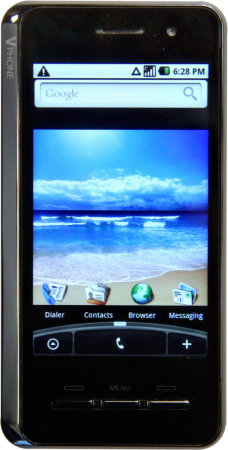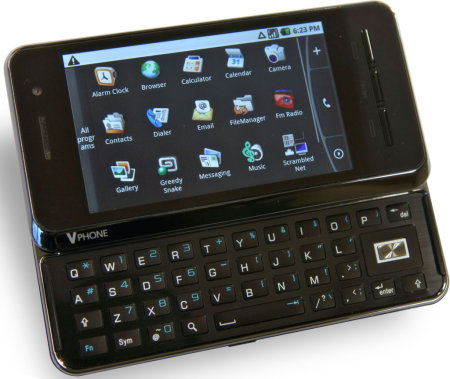Third Verizon Android phone a videophone?
Nov 16, 2009 — by Eric Brown — from the LinuxDevices Archive — viewsFollowing its release of Motorola's Droid and HTC's Droid Eris, Verizon Wireless will release a third Android phone made by Saygus, say reports. The Saygus VPhone V1 offers a 624MHz Marvell PXA310, a 3.5-inch 800 x 480 pixel touchscreen, a QWERTY keyboard, and proprietary videoconferencing technology, says Saygus.
Rumors that Verizon will offer the Saygus VPhoneV1 have popped up on several sites, though there has been no official confirmation from either the carrier or Saygus. According to Phandroid, a Verizon version of the VPhone V1 can be expected in early 2010, making it the third Android model offered by Verizon Wireless after its Droid by Motorola and HTC Hero-based Droid Eris phones.

Saygus VPhone V1
The VPhone V1 is based on a 624MHz Marvell PXA310 with 256MB of RAM and 512MB flash, and supports an SDHC card up to 16GB in capacity. The 4.6 x 2.3 x 0.8-inch phone sports a 3.5-inch capacitive, 800 x 480 touchscreen and a slide-out QWERTY keyboard, says Saygus.
Supporting CDMA2000 EV-DO Rev. A on CDMA 800Mhz /1900Mhz networks, the phone provides WiFi, Bluetooth, FM radio, and a five-megapixel camera, says the company. Other features are said to include GPS, accelerometers, digital compass, USB, microphone, speakers, and a 1500 mAh battery offering talk time of up to seven hours.

VPhone with keyboard open
(Click to enlarge)
Other touted features include server-based backup, plus the ability to view movie downloads in "full color HD" and "surround sound type 3D audio."
Stated Saygus CEO Chad Sayers, founder of Saygus Inc. and creator of the V1, "This new mobile live video device empowers individuals separated by distance to view real-time conditions nearly anywhere in the world where cellular communications are available."
Availability
The Saygus VPhone V1 will be available in the fourth quarter, says Saygus. The Saygus site covering the VPhone may be found here, and the Phandroid story on Verizon's plans for the phone should be here.
This article was originally published on LinuxDevices.com and has been donated to the open source community by QuinStreet Inc. Please visit LinuxToday.com for up-to-date news and articles about Linux and open source.